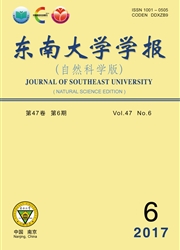

 中文摘要:
中文摘要:
为了解释有关纳米通道内离子输运特性的一系列违反经典流体力学和电迁移理论的实验现象的内在机理,通过分子动力学模拟的方法,研究了受限高浓度Na Cl溶液的离子电流和迁移率等电动力学输运特性.结果显示,跨膜电压和接入电阻是导致单层石墨烯纳米孔的离子电流随孔径呈线性增长的重要原因.受限电解质溶液与体态溶液的本质区别是除了固液界面的边界效应外,跨膜电压造成的局部超大电场将导致电迁移速率随电场强度增加出现非线性增长的Wien效应.同时,离子迁移率随溶液浓度升高而下降.产生这些变化的微观机理除了离子氛屏蔽效应外,还有离子对形成和离子碰撞等离子间微观相互作用.
 英文摘要:
英文摘要:
To explain the mechanism of ion transport in nanochannel behind a series of phenomena which can not be explained by classical fluid mechanics and electrical transport theory,by all-atom molecular dynamics( MD) simulations,ionic current and ion mobility as well as other electrokinetics transport properties of confined sodium chloride solution are investigated. The results indicate that transmembrane voltage and access resistance have a significant contribution to the linear growth of the ionic current of monolayer graphene nanopore with pore diameter increasing. The essential difference between confined electrolyte solution and bulk solution is that despite the boundary effect on solid-liquid interface,ultra-high localized electrical field caused by transmembrane voltage leads to the Wien effect,that is,ion mobility nonlinearly increases with electrical field rising. Furthermore,the ion mobility decreases as the bulk concentration increases. In addition to the ionic atmosphere effect,the microscopic mechanism is the interaction between ions including ion pair formation and the ion-ion collisions.
 同期刊论文项目
同期刊论文项目
 同项目期刊论文
同项目期刊论文
 期刊信息
期刊信息
